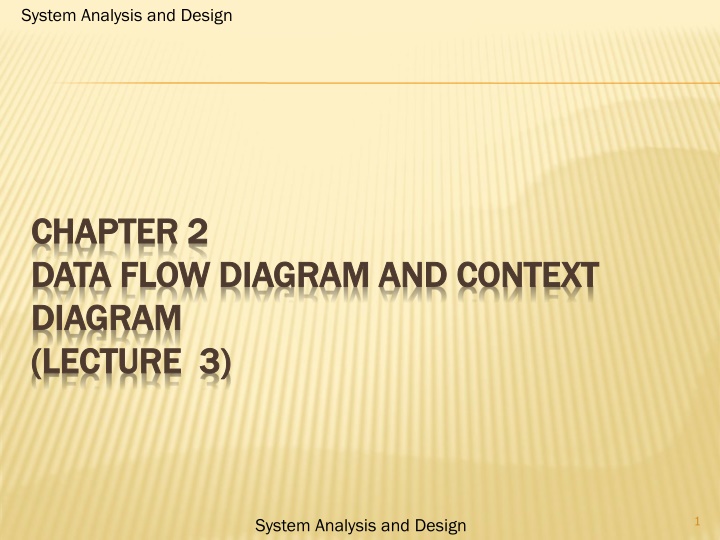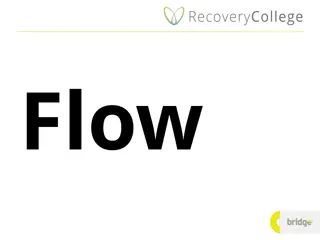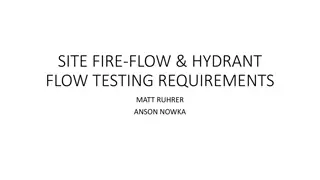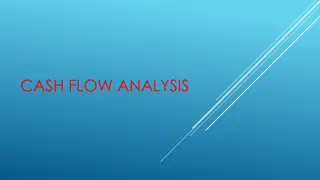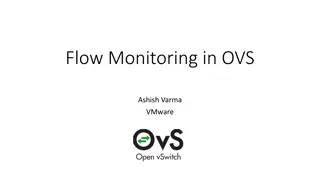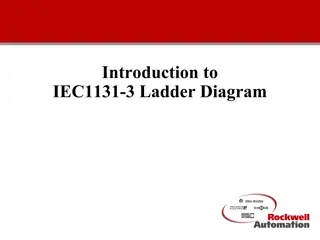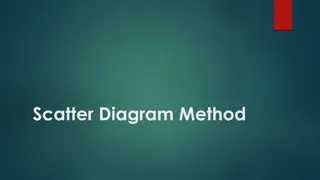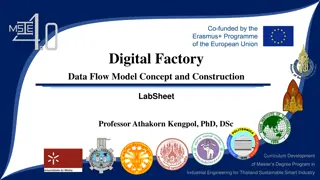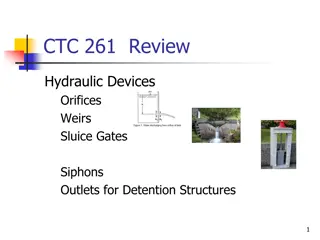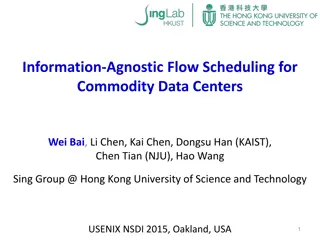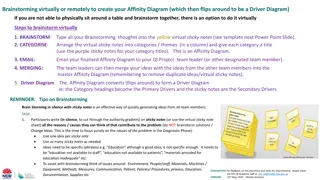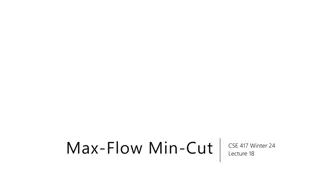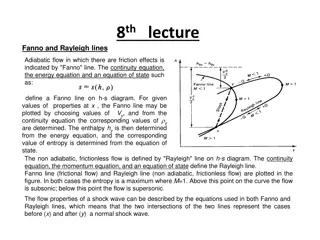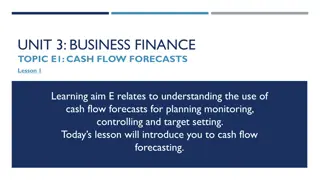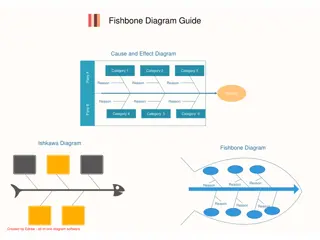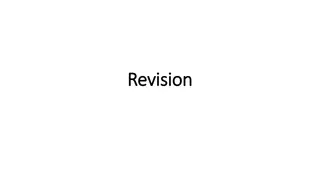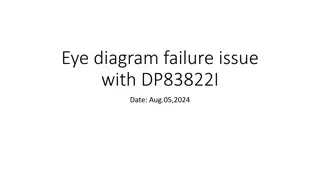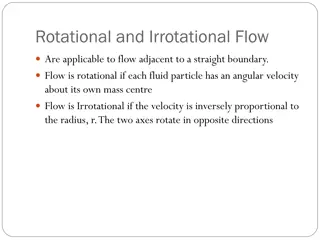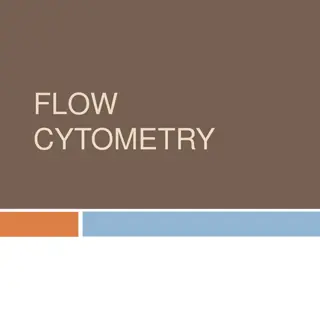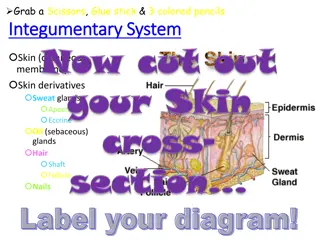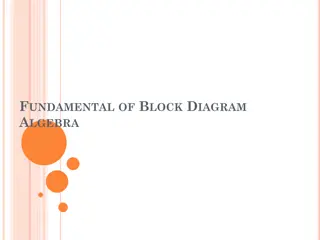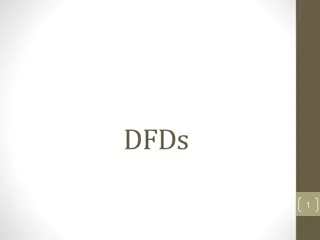DATA FLOW DIAGRAM AND CONTEXT DATA FLOW DIAGRAM AND CONTEXT
How Data Flow Diagrams (DFDs) help depict data movement in information systems, using symbols like processes, data flows, stores, and entities. Understand the basics of creating DFDs and the significance of context diagrams.
Download Presentation

Please find below an Image/Link to download the presentation.
The content on the website is provided AS IS for your information and personal use only. It may not be sold, licensed, or shared on other websites without obtaining consent from the author.If you encounter any issues during the download, it is possible that the publisher has removed the file from their server.
You are allowed to download the files provided on this website for personal or commercial use, subject to the condition that they are used lawfully. All files are the property of their respective owners.
The content on the website is provided AS IS for your information and personal use only. It may not be sold, licensed, or shared on other websites without obtaining consent from the author.
E N D
Presentation Transcript
System Analysis and Design CHAPTER CHAPTER 2 2 DATA FLOW DIAGRAM AND CONTEXT DATA FLOW DIAGRAM AND CONTEXT DIAGRAM DIAGRAM (LECTURE (LECTURE 3 3) ) 1 System Analysis and Design
MAIN MAIN TOPICS TOPICS What is a Data Flow Diagram (DFD)? Data Flow Diagram Symbols. Creating a Set of DFDs Context Diagram Rules Governing Data Flow Diagramming System Analysis and Design 2
DATAFLOW DIAGRAM The dataflow diagram is a modeling tool that allows us to picture a system as a network of functional processes, connected to one another by pipelines and holding tanks of data System Analysis and Design 3
DATA FLOW DIAGRAMS DATA FLOW DIAGRAMS A data flow diagram (DFD) shows how data moves through an information system. A set of DFDs provides a logical model that shows what the system does, not how it does it. Systems analysts use A DFD as a graphical technique to describe an information system. System Analysis and Design 4
DATA FLOW DIAGRAMS SYMBOLS DFDs use four basic symbols that represent processes, data flows, data stores, and entities. System Analysis and Design 5
DATA FLOW DIAGRAM SYMBOLS Entity Data store Process (Source/Sink) Data flow System Analysis and Design 6
DATA FLOW DIAGRAMS SYMBOLS Process symbol Process symbol The process shows a part of the system that transforms inputs into outputs; that is, it shows how one or more inputs are changed into outputs . Resembles a black box, where the inputs, outputs, and general function of the process are known, but the underlying details are not shown. System Analysis and Design 7
DATA FLOW DIAGRAMS SYMBOLS Process symbol Process symbol -The process is represented graphically by this symbol. Process - A good name will generally consist of a verb-object phrase such as VALIDATE INPUT VALIDATE INPUT ro COMPUTE TAX RATE COMPUTE TAX RATE - The exception is a process that represents an entire system or subsystem. System Analysis and Design 8
DATA FLOW DIAGRAMS Data Flow Diagrams Symbols Data flow symbol Data flow symbol A flow is represented graphically by an arrow into or out of a process. The flow is used to describe the movement of chunks, or packets of information from one part of the system to another part. Thus, the flows represent data in motion, whereas the stores represent data at rest . Data flow System Analysis and Design
Data Flow Diagrams Symbols Data store symbol Data store symbol Represent data that the system stores Typically, the name chosen to identify the store is the plural taht stekcap eht fo eman eht fo erots eht fo tuo dna otni swolf yb deirrac era . Data store is represented graphically by paralleled bars or parallel lines Data store System Analysis and Design
Data Flow Diagrams Symbols The The Entity Entity Symbol Symbol Entities represent external entities with which the system communicates. External entity that is origin or destination of data (outside the system). The Entity may be source/sink. Source/Sink Source Entity that supplies data to the system Sink Entity that receives data from the System Analysis and Design
Data Flow Diagrams Symbols The Entity Entity Symbol Is the singular form of a department, outside organization, other IS, or person. AnEntity Entityis represented graphically bya rectangle Name of the Entity Entity appears inside the symbol and should be noun phrases. System Analysis and Design
DATA FLOW DIAGRAMS DATA FLOW DIAGRAMS Context Diagrams Context Diagrams Top-level view of an information system that shows the system s boundaries and scope Do not show any data stores in a context diagram because data stores are internal to the system. Begin by reviewing the system requirements to identify all external data sources and destinations System Analysis and Design 13
CONTEXT DIAGRAMS CONTEXT DIAGRAMS Record the name of the entities and the name and content of the data flows, and the direction of the data flows. What makes one system more complex than another is the number of components, the number of levels, and the degree of interaction among its processes, entities, data stores, and data flows System Analysis and Design 14
Context Diagrams Context Diagrams Shows the overall business process as just one process. The process is given the number zero. Shows all the outside entities that receive information from or contribute information to the system Slide 15 System Analysis and Design
Context Diagrams Context Diagrams Each context diagram must fit on one page. The process name in the context diagram should be the name of the information system. Use unique names within each set of symbols. Do not cross lines. Use a unique reference number for each process symbol. 1. 2. 3. 4. 5. System Analysis and Design 16
DEVELOPING DFDS 1. Context Diagram for Pizza Hut food ordering system 0 0 CUSTOMER KITCHEN Food Ordering System Food Order Customer Order Receipt Management Reports RESTAURANT MANAGER System Analysis and Design 17
Creating a Set of DFDs Creating a Set of DFDs Create a graphical model of the information system based on your fact-finding results Performing three main tasks Step 1: Draw a context diagram Step 2: Draw a diagram 0 DFD Step 3: Draw the lower-level diagrams 18 System Analysis and Design
Creating a Set of DFDs Creating a Set of DFDs Draw a Diagram 0 DFD Diagram 0 Zooms in on the context diagram and shows major processes, data flows, and data stores Must retain all the connections that flow into and out of process 0 Each process has a reference number Diverging data flow 19 System Analysis and Design
Creating a Set of DFDs Creating a Set of DFDs Draw the Lower-Level Diagrams Must use leveling and balancing techniques Leveling Uses a series of increasingly detailed DFDs to describe an information system Exploding, partitioning, or decomposing 20 System Analysis and Design
DATA FLOW DIAGRAMS Lower-Level Diagrams Balancing Ensures that the input and output data flows of the parent DFD are maintained on the child DFD System Analysis and Design
DEVELOPING DFDS 1. Context Diagram for Pizza Hut food ordering system 0 0 CUSTOMER KITCHEN Food Ordering System Food Order Customer Order Receipt Management Reports RESTAURANT MANAGER System Analysis and Design 22
DEVELOPING DFDS 2. Level-0 Diagram for Pizza Hut food ordering system 1.0 1.0 Customer Order Receive & Transform Customer Food Order CUSTOMER KITCHEN Food Order Receipt 2.0 2.0 3.0 3.0 Inventory Data Goods Sold Update Goods Sold File Update Inventory File Formatted Goods Sold Data Formatted Inventory Data D2Goods Sold File D1 Inventory File 4.0 4.0 Daily Inventory Depletion Amounts Daily Goods Sold Amounts Produce Management Management Reports manager System Analysis and Design Report 23
DEVELOPING DFDS 2. Level-1 Diagram for Pizza Hut food ordering system 1.1 1.1 1.3 1.3 Customer Order Customer Order Transform Order to Kitchen Format Food Order Receive Customer Order Customer Order 1.5 1.5 Inventory Data Customer Order Generate Inventory Decrements Customer Order 1.2 1.2 1.4 1.4 Goods Sold Data Receipt Generate Goods Sold Increments Generate Customer Receipt System Analysis and Design 24
RULES GOVERNING DATA FLOW DIAGRAMMING 25 System Analysis and Design
RULES GOVERNING DATA FLOW DIAGRAMMING PROCESS Rule 1: Process cannot have outputs only. It means it is making data from nothing Only a source should have outputs without inputs System Analysis and Design 26
Rules Governing Data Flow Diagramming Process Rule 2: No Process can have only inputs If an object has only inputs, then it must be a sink. System Analysis and Design 27
Rules Governing Data Flow Diagramming Process Rule 3: A Process should have a verb phrase label Generate Orders System Analysis and Design 28
RULES GOVERNING DATA FLOW DIAGRAMMING PROCESS Rule 4: Data cannot move directly from one data store to another data store. Data must be moved by a process Generate Orders System Analysis and Design 29
RULES GOVERNING DATA FLOW DIAGRAMMING PROCESS Rule 5: Data cannot move directly from an outside source to a data store Data must be moved by a process which receives data from the source and places the data into the data store Generate Orders Source Source System Analysis and Design 30
RULES GOVERNING DATA FLOW DIAGRAMMING PROCESS Rule 6: Data cannot move directly to an outside sink from a data store Data must be moved by a process Generate Orders Sink Sink System Analysis and Design 31
RULES GOVERNING DATA FLOW DIAGRAMMING PROCESS Rule 7: A data store has a noun phrase label Inventory System Analysis and Design 32
RULES GOVERNING DATA FLOW DIAGRAMMING PROCESS Rule 8: A data store A data store must have at least one incoming and one outgoing data flow. Inventory System Analysis and Design 33
RULES GOVERNING DATA FLOW DIAGRAMMING PROCESS Source/Sink Rule 9: Data cannot move directly from a source to a sink It must be moved by a process Generate Orders Sink Source Sink Source System Analysis and Design 34
RULES GOVERNING DATA FLOW DIAGRAMMING PROCESS Source/Sink Rule 10: A source/sink has a noun phrase Supplier System Analysis and Design 35
RULES GOVERNING DATA FLOW DIAGRAMMING PROCESS Data flow Rule 11: A data flow has only one direction of flow between symbols It may have both direction flows between a process and a data store to show a read before an update Later it is indicated by two separate arrows Generate Orders Generate Orders System Analysis and Design 36
RULES GOVERNING DATA FLOW DIAGRAMMING PROCESS Data flow Rule 12: A fork in a data flow means that exactly the same data goes from a common location to two or more different processes, data stores, or sources/sinks. There should not be a variation in duplication A A A A A A B B System Analysis and Design 37
RULES GOVERNING DATA FLOW DIAGRAMMING PROCESS Data flow Rule 13: A joint in a data flow means that exactly the same data comes from any of two or more different processes, data stores, or sources/sink to a common location Only similar data flows can be joined A A A A B B A A System Analysis and Design 38
RULES GOVERNING DATA FLOW DIAGRAMMING PROCESS Data flow Rule 14: A data flow cannot go directly to the same process it leaves. There must be at least one other process which handles the data flow, produces some other data flow, and returns the original data flow to the beginning process B B A A A A A A System Analysis and Design C C 39
RULES GOVERNING DATA FLOW DIAGRAMMING PROCESS Data flow Rule 15: A data flow to a data store means update (delete or change) Delete or changed data Generate Orders System Analysis and Design 40
RULES GOVERNING DATA FLOW DIAGRAMMING PROCESS Data flow Rule 16: A data flow from a data store means retrieve or use Retrieve/Use Generate Orders System Analysis and Design 41
Rules Governing Data Flow Diagramming Process Data flow Rule 17: A data flow must have a noun phase label Updated stock System Analysis and Design 42
DFDS EXERCISES DFDS EXERCISES 43 System Analysis and Design
DATA FLOW DIAGRAMS Examples of correct uses of data store symbols in a data flow diagram. [1] System Analysis and Design 44
DATA FLOW DIAGRAMS System Analysis and Design 45
DATA FLOW DIAGRAMS Entity can be connected with a process only Examples of correct uses of external entities in a data flow diagram.[ Examples of correct uses of external entities in a data flow diagram.[1 1] ] System Analysis and Design 46
DATA FLOW DIAGRAMS System Analysis and Design 47
DATA FLOW DIAGRAMS System Analysis and Design 48
DFD ERRORS System Analysis and Design 49
DFD ERRORS System Analysis and Design 50
